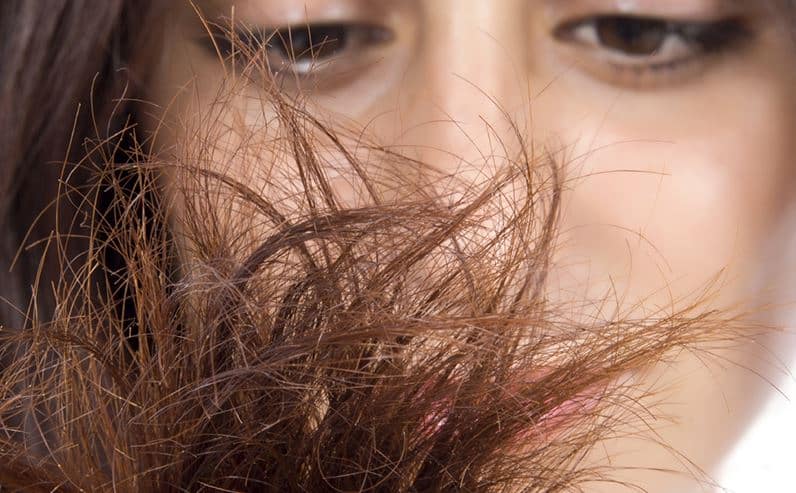Female Pattern Baldness: Causes And Treatment Explained

In the past, women have been referred to as ‘the fairer sex’. Some women find the term downright offensive, whether you mean ‘fair’ in reference to physical beauty, or in reference to conduct and everyday behavior. Women do not like judgments on the sole basis of their looks, and they do not enjoy broad generalizations. Most of them are not big fans of female pattern baldness, either. But it happens.
Pattern baldness in human males is a highly prevalent and well-known condition. If you are a guy, it is more unusual for you to keep your hair than to lose it. In females, it is not so unusual. First, pattern baldness in females is not as common as with males. And secondly, it does not express itself in the same way, and the differences are apparent. That said, pattern baldness does occur to a large number of women, so let’s see what it’s about.
What is Female Pattern Baldness?

Woman with healthy hair.
First things first, what is female pattern baldness? The term for this condition is androgenic (or androgenetic) alopecia. It’s the name given to pattern baldness in males and females, and it has been a part of our lives since time immemorial. It is natural to shed as much as 150 hairs every day, but there are times when the hair loss begins to increase at a noticeable rate. Various types of alopecia exist, and androgenic alopecia is the most widely-seen variety, affecting a rather large percentage of the population.
Our hairs are constantly going through different phases in their life cycle. There are three main stages of existence for the hairs on our head: anagen, catagen, and telogen, and in layman’s terms, growth, transition, and shedding.
Growth – the growing hair is pushed out of the scalp by the root, or follicle. The hair grows approximately half an inch every month, and it can do this for years at a time. It’s possible to cut the anagen phase short in some cases, like stress or illness.
When the body is going through something major, physical or mental, it may reroute resources to vital organs and crucial physiological processes. Since hairs are not considered essential for life, they may stop growing earlier than usual.
Transition – the follicle renews itself. It shrinks and then goes back to its “default setting”. At this point the hair which it has been maintaining stops growing, and it no longer receives nourishment from the follicle, even though it is still on the head. The catagen phase is the shortest of the 3 stages, and it normally lasts between 10-20 days.
Shedding – the hair is shed naturally to make room for new growth. Once the hair is shed, the follicle lies dormant for a few months before starting the cycle over again, sprouting a new hair in the process. The telogen stage is also called the resting phase, due to the follicle’s inactivity.
But at some point – this is more common after menopause has taken place – the tides of the hair follicles may begin to turn. The rate of female hair loss moves up and down, somewhat dramatically. It usually comes in waves of shedding lasting several months, with long periods of rest (up to a year or two) in between them. Since female hair loss is usually spaced apart in such a way, it is a process which – if left to own devices – can go on for decades.
What Are The Causes of Female Pattern Baldness?

Unhealthy hair can be a pain.
The cause of female pattern baldness is usually a combination of increased hair shedding and a heightened sensitivity (on the part of the head’s hair) to certain pre-existing hormones. Each of those two factors can be a good enough cause on its own. However, it’s usually it is some kind of combination of the two which causes the pattern hair loss in women.
Even women with normal levels of male and female sex hormones can develop this condition. It was once thought that an increase in the levels of testosterone – and more specifically in its derivative dihydrotestosterone (DHT) – could be the cause of hair loss in men and women. But it seems to be a sensitivity which can be triggered even with normal levels of sex hormones.
In the beginning stages of puberty, DHT and its “parent hormone” testosterone are essential for sexual maturity and growth. Sometimes after puberty has kicked in – it can be months or decades later – the body becomes sensitive to DHT, and this causes the hair to thin and/or fall out.
There are those who are content with laying the blame at the feet of genetic predisposition, but there are others who don’t find this answer satisfactory in the least. They assert that saying “oh, it’s genetic” is the easy way out, and that it serves the interests of Big Pharma, who are interested in selling hair-growth products more than finding a cure.
Is Female Pattern Baldness Reversible?
Like male pattern hair loss, female pattern baldness can start slowing down, but it cannot stop or reverse. There is no cure for female pattern hair loss at the moment. Even though many sharletans will be glad to sell you some good ol’ snake oil to place on your scalp. So as to whether female pattern baldness is reversible, is debatable on grounds of circumstance.
What creates pattern hair loss is often described as a deviation from the normal hair-growth cycle. The cycle brakes for one reason or another, and the follicles react accordingly. Because of that, androgenic alopecia is a condition which should be reversible and treatable, theoretically speaking. Once you are able to bring things back to balance, hairs should resume their natural state and carry on accordingly. Although, in cases where the condition is already more advanced, the chances of regaining that balance grow ever slimmer.
Can Female Pattern Baldness Be Prevented?

Damaged hair.
Again, this is a question of genetics and early treatment, but the answer is essentially no. Female pattern baldness cannot be prevented, only mitigated. In truth, it looks as though the fate of our hair rests on the seemingly-arbitrary whims of biological processes.
For those females who only have a mild hereditary baldness factor, it is conceivable that proper diet, healthy lifestyle, and balanced hair maintenance can contribute to the longevity of their hairs’ life. It can be controlled or contained a lot more than male pattern hair loss, that is for sure. Even so, nothing is preventable with 100% success. This remains true even if you take all measures to counter the condition.
Also, keep in mind that hair shedding is a normal occurrence at any point in your life. We all shed hairs every day, and it is part of the process.
Minoxidil And Female Pattern Baldness Explained
Minoxidil, or Rogaine, in the US, is the only FDA-approved over-the-counter hair-loss and hair-growth treatment available for women. It proves to be an effective and useful way to delay the shedding and prolonging the hair’s growth stage. This all adds up to stronger and thicker hair for longer periods of time.
Minoxidil seems to be efficient, though not in all cases. As I said before, it is dependent on variables like early diagnosis, physical location of the alopecia (since minoxidil does not affect the scalp equally), psychological stress and/or trauma, and other factors. The company’s website cites a placebo-controlled clinical study where Rogaine helped over 80% of the women regrow hair.
The downside of Minoxidil, or any hair-growth or hair-loss drug for that matter, is that once you stop taking it the hair will revert back to its prior state. Like I said, it is a commitment on the part of the patient. You shouldn’t just start it, give it a few weeks, become frustrated, and then bail. It will take time and patience to see real-life results, so don’t expect anything fast.
What Is The Best Treatment For Female Hair Loss?

Woman with healthy hair.
That’s the question, isn’t it – what is best? Unfortunately, there is no single answer. The best treatment for female hair loss would be to consult with a healthcare professional, get a proper diagnosis, rule out deficiencies, allergies, or maladies, and then take it from there. As for treatment, minoxidil is the only topical drug with FDA approval for women. However, there are plenty of dietary supplements. There are hair transplants, light therapy, and let’s not forget the use of alternative medical practices, plus wigs and hats.
Hair transplants are a commitment, but female pattern hair loss is less about balding and more about thinning. It is quite possible to achieve satisfying initial results after one or two sessions at a good hair restoration clinic. The advancements made in the field of surgical hair restoration technology are significant, and it is worth looking into. Keep in mind that even then, it will take 4-6 months for real results to show. In the realm of alternative medicine, there are many ways to approach the matter of alopecia, and here are just a few:
Medical procedures – acupuncture, ayurveda, homeopathy.
Biological treatment – diet, vitamin therapy, folk remedies.
Physical manipulation – massage techniques and chiropractic methods of adjustment.
Wigs are also an option. A well-done and well-placed wig can feel and look as natural as hair can be. The loss of hair can be a disconcerting and upsetting experience for either sex, but women tend to experience less physical hair loss overall, making it less common for their sex, and therefore more stressful for females who suffer from it, by and large.
Hats are the thing I am mentioning last, because a hat is literally a cover-up, and is not a long-term solution or satisfying treatment in any way. But a hat can be stylish and spiffy, and it is definitely something to consider for short-term supermarket excursions and basic day-to-day errands and such.
Conclusion
Don’t fret! Hair cloning is right around the corner. Sure, but they also said that in the late 90s, and still there is no cure for androgenic alopecia. Well, you know what they say: you can’t rush inspiration. All it takes is one researcher to accidentally stumble upon a breakthrough, and BOOM.
Female pattern hair loss remains the bane of post-menopausal women everywhere. Fortunately for them, the numbers aren’t nearly as bad as with the guys. That said, it is a cause for concern among many women, and nothing to scoff at because of its lesser prevalence. It’s still something which affects people every day, causing them shame, grief, and sorrow.
Like I said, the first step is to get a proper diagnosis. You never know what it could be, for better or worse. Could be a vitamin deficiency, a thyroid gland issue, or any number of things which affect the follicles. If you try and self-medicate with Rogaine while actually suffering from a lack of zinc in your body, then good luck to you. Just like it says in Sun Tzu’s Art of War, you need to know yourself and you need to know your enemy.
I feel the future is looking bright for pattern hair loss, in both males and females. That is to say, it seems to be something which science will be able to overcome and find a definitive solution for, in due season. Remember – minoxidil was first sold as a pill for treatment of hypertension. You never know what’s gonna happen. Accidental science is accidental.


